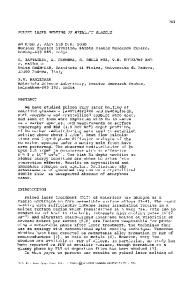Microstructural Design by Controlled Crystallization of Metallic Glasses
- PDF / 1,608,911 Bytes
- 12 Pages / 595 x 842 pts (A4) Page_size
- 96 Downloads / 393 Views
MM1.2.1
Microstructural Design by Controlled Crystallization of Metallic Glasses Uwe Köster, Rainer Janlewing Dept. Biochem. & Chem. Eng., University of Dortmund, D-44221 Dortmund, Germany
Abstract: Nanocrystalline materials can be produced e.g. by high energy ball milling or vacuum condensation; these methods require powder compaction as a final step. In another route - the nano-crystallization - metallic glasses are used as precursors for nanocrystalline materials without any porosity. The conditions for achieving an ultra-fine grained material by crystallization are small growth, but large nucleation rates. Whereas in Fe-Ni-B glasses the finest microstructure is produced at annealing temperatures above the glass transition close to the maximum of the nucleation rate, in Zr-based metallic glasses nanocrystallization was found to proceed only at relatively low temperatures below the glass transition. The aim of this contribution is to study systematically the micromechanisms involved in the microstructural design. Crystallization was studied in detail in Fe-Ni-B and Zr-based metallic glasses by means of TEM, X-ray diffraction and DSC. Nucleation and growth rates were estimated from crystallization statistics. By modeling the obtained time-dependent nucleation rates in the framework of diffusion controlled classical nucleation all relevant crystallization parameter could be derived. Using these data TTT-diagrams could be drawn and annealing conditions deducted, e.g. for the formation of a nanocrystalline alloy. Isothermal DSC plots for polymorphic crystallization can only be explained with a very significant decrease in the growth rate at later stages. Such a decrease is assumed to result from stresses building up during crystallization beyond the percolation limit for the crystalline phase; under this condition stresses resulting from the volume change during crystallization cannot be compensated by viscous flow as in the case of isolated crystals in an amorphous matrix.
Introduction: The development of bulk metallic glasses, in particular in Zr-based alloys, as well as partially nanocrystalline alloys formed by crystallization of glassy precursors led to an increased interest in the micromechanism of crystallization. Zr-Cu-Ni-Al is known as one of the best glass forming alloys known [1]; any study on crystallization is of utmost importance in order to maintain its high thermal stability. On the other hand, in a narrow concentration range around the composition for best glass formation a large variety of microstructures exhibiting different phases as well as grain sizes can be designed by controlled thermal treatment. These glasses, e.g. Zr69.5Cu12Ni11Al7.5, can be used as precursor material for the formation of icosahedral quasicrystals [2,3]. Partial nano-quasicrystalline structures are of interest, since quasicrystals exhibit a rather small interfacial energy thus leading to relative stable nanocrystalline structures with interesting mechanical properties [1]. The aim of this paper is to review our recent kno
Data Loading...











